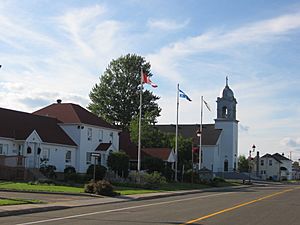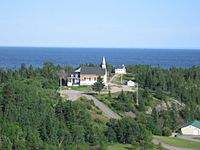Port-Cartier facts for kids
Quick facts for kids
Port-Cartier
|
|
|---|---|
|
City
|
|
 |
|
| Country | Canada |
| Province | Quebec |
| Region | Côte-Nord |
| RCM | Sept-Rivières |
| Settled | 1916 |
| Constituted | February 19, 2003 |
| Area | |
| • Total | 1,371.79 km2 (529.65 sq mi) |
| • Land | 1,092.75 km2 (421.91 sq mi) |
| Population
(2021)
|
|
| • Total | 6,516 |
| • Density | 6.0/km2 (16/sq mi) |
| • Pop (2016-21) | |
| • Dwellings | 3,307 |
| Time zone | UTC−5 (EST) |
| • Summer (DST) | UTC−4 (EDT) |
| Postal code(s) |
G5B
|
| Area code(s) | 418 and 581 |
| Highways | |
Port-Cartier is a city in the Quebec province of Canada. It is located in the Côte-Nord region, which is on the north shore of the St. Lawrence River. The city sits where the Aux-Rochers River meets the St. Lawrence. It is about 63 kilometers (39 miles) southwest of another city called Sept-Îles, Quebec.
In 2021, Port-Cartier had a population of 6,516 people. The city covers a large land area of about 1,092 square kilometers (422 square miles). This makes it one of the largest cities in Canada by land size. Besides the main city, other smaller communities like Rivière-Pentecôte, Pointe-aux-Anglais, Baie-des-Homards, and Grand-Ruisseau are also part of Port-Cartier. These communities are all found along Quebec Route 138.
Contents
History of Port-Cartier
The story of Port-Cartier began in 1915. A man named Colonel Robert R. McCormick, who owned the Chicago Tribune newspaper, visited the area. He wanted to see if the forests around the Rochers River could be used for wood. Soon after, a small settlement was started on the west side of the river's mouth. It was first called Shelter Bay.
A post office opened in Shelter Bay in 1916. Then, a sawmill was built in 1918, which cut logs into lumber. In 1920, a factory opened to remove bark from trees. However, by 1955, most of the trees had been cut down, so the factory closed.
In 1958, a new company called the Québec Cartier Mining Company came to the area. They built a plant to process iron ore. Iron ore is a rock from which iron can be taken. They also built a special port in the sea near Shelter Bay. This port was made to ship the iron ore that was mined from places like Lake Jeannine near Fermont.
The new town was named Port-Cartier after the mining company. It officially became a town in 1959. The next year, Shelter Bay joined Port-Cartier. The original Shelter Bay area is now known as Port-Cartier West. Today, the port is very busy, handling about 18 million tons of cargo each year. It is the third busiest port in Quebec for the amount of goods it handles.
Rivière-Pentecôte's Past
In 1875, a small community called Saint-Patrice-de-la-Rivière-Pentecôte was started. It was about 100 kilometers (62 miles) southwest of Sept-Îles, at the mouth of the Pentecôte River. The name "Pentecôte" comes from explorer Jacques Cartier. He arrived at this spot on the day of Pentecost in 1535.
The "Penticost River" Post Office opened in 1884. Its name was changed to Rivière-Pentecôte in French in 1933. By the late 1800s, it was one of the most important industrial places along the North Shore. In 1972, Rivière-Pentecôte officially became a municipality.
On February 19, 2003, the Municipality of Rivière-Pentecôte joined with the city of Port-Cartier.
Population and Language
In 2021, Port-Cartier had 6,516 residents. This was a small decrease of 4.2% from its population in 2016. The city has a land area of about 1,092.75 square kilometers, meaning there are about 6 people per square kilometer.
Most people in Port-Cartier speak French as their first language. In 2021, about 97.1% of the people spoke French. A smaller number, about 1.3%, spoke English as their first language.
Port-Cartier Institution
The Correctional Service of Canada runs a special facility called the Port-Cartier Institution. It is a maximum-security prison for men and is located about two kilometers north of the city. This institution helps people who have been in trouble with the law. It offers different programs and services to help them learn new skills. The goal is to help them become good citizens when they leave the prison.
The Port-Cartier Institution is known for its focus on education and job training. There are many courses available to help people develop new skills. This prepares them to find work and live successfully after they are released.
See also
 In Spanish: Port-Cartier para niños
In Spanish: Port-Cartier para niños



